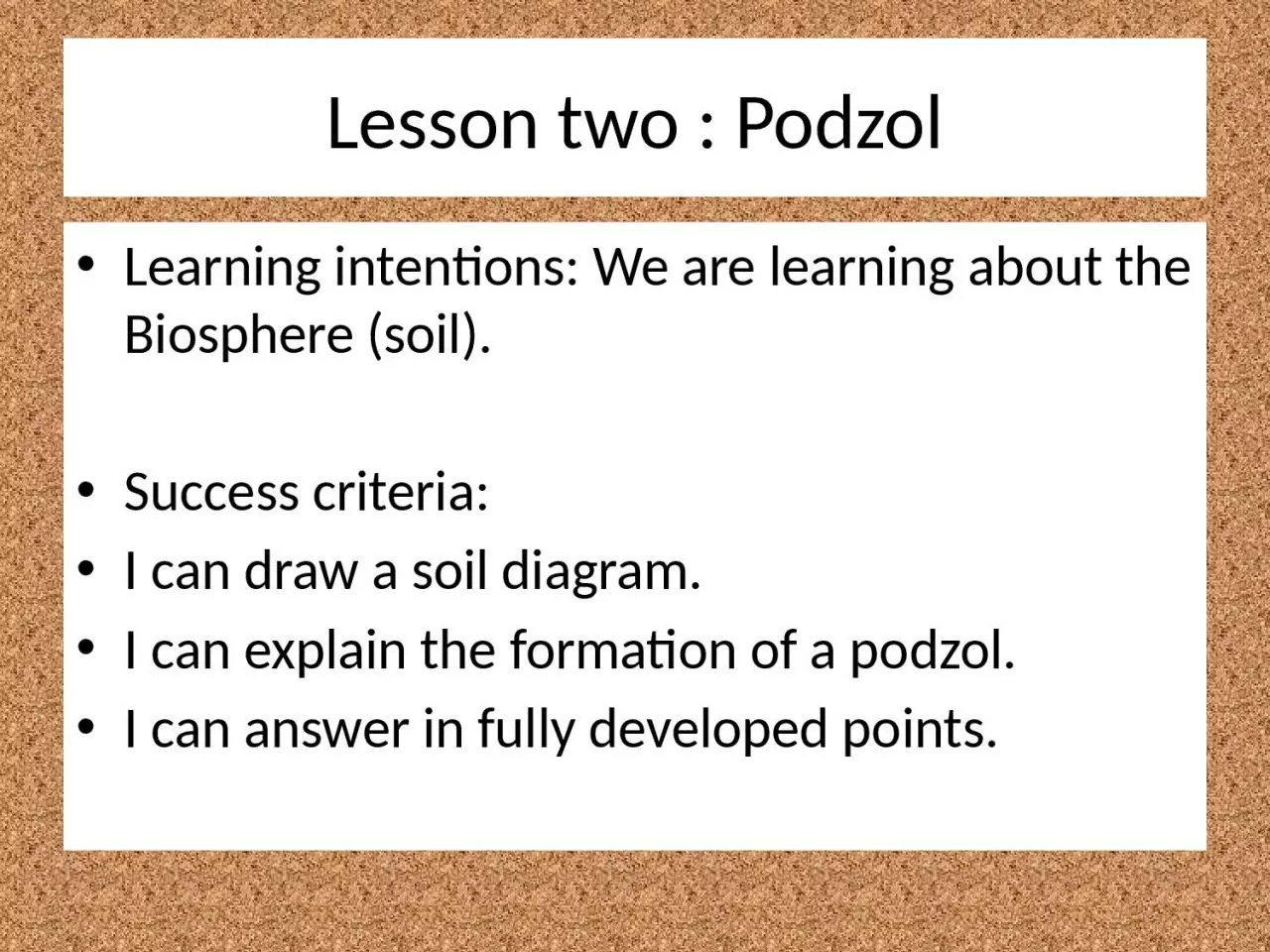

Success criteria I can draw a soil diagram I can explain the formation of a podzol I can answer in fully developed points Starter Heading Podzol Draw this diagram in the middle of your page ID: 1022572
Download Presentation The PPT/PDF document "Lesson two : Podzol Learning intentions..." is the property of its rightful owner. Permission is granted to download and print the materials on this web site for personal, non-commercial use only, and to display it on your personal computer provided you do not modify the materials and that you retain all copyright notices contained in the materials. By downloading content from our website, you accept the terms of this agreement.
1. Lesson two : PodzolLearning intentions: We are learning about the Biosphere (soil).Success criteria:I can draw a soil diagram.I can explain the formation of a podzol.I can answer in fully developed points.
2. StarterHeading: PodzolDraw this diagram in the middle of your page.
3. What you need to knowYou will need to know what the soil profile looks like for each of the soils. A soil profile is a vertical section through a soil (as if you had sliced a spade through the soil until you hit hard rock). You will not be specifically asked to draw a soil profile in the end of year exam, however annotated diagrams can gain you full marks.
4. Soil profile
5. Soil profileThe top layer is the AO horizon which consists of decaying organic matter from the vegetation above. The two layers below, the A and B horizons, are made up from the products of the AO horizon, and are greatly influenced by the soil forming processes, thus resulting in distinct colours, texture and water content. The C horizon at the bottom contains the parent material. AOABC
6. Podzol
7. What is the relationship between location of Podzols and Relief?
8. PozolPodzol soils are found in the northern boreal coniferous forests and are associated with cold, wet climates.They are also found in upland moors.Precipitation is greater than evaporation.Boreal forest – Canada, Russia, Siberia, Northern China, Northern Japan.
9. KEYRed: soil organismsGreen: vegetationBlue: climatePink: parent material (rock type)Black: drainage/relief (these are very closely linked)
10. Using the information on pages 5 and 6, Explain how the factors such as the ones stated affect the formation of a podzol soil. (6) Natural vegetation, Climate, Relief, Soil organisms, Drainage, and Rock type.
11. Thin, black acidic mor humus with a pH 3.5 – 4 produced from the slow decomposition of coniferous pine needles and cones in a cold wet climate.The climate is cold and wet. Precipitation > evaporation which causes leaching and waterlogging. Podzolisation can also take place making the soil acidic.Limited bacterial activity because of the cold wet climate which results in slow soil formation and thin/shallow soil.Due to the cold climate present for most of the year there are few soil organisms to vertically mix the soil so the horizons are clearly defined.Since P>E there is the downward leeching of minerals resulting in an ash-grey horizon.An iron pan develops in the illuviation zone in the upper B horizon as a result of the redeposition of iron, and this can impede drainage resulting in waterlogging and gleying the B horizon.In the C horizon parent material is generally weathered fluvioglacial material with a mixture of particle shapes and sizes.
12. Task 2Using the previous slide, complete your diagram of the podzol using coloured pencils.Using the information on pages 5 and 6, Explain how the factors such as the ones stated affect the formation of a podzol soil. (6) Natural vegetation, Climate, Relief, Soil organisms, Drainage, and Rock type.
13. Perfect AnswerPodzols are found in cold and wet climates where precipitation exceeds evaporation. This leads to downward leeching of minerals producing an ash-grey A horizon. Podzols have a thin, black acidic mor humus with a pH 3.5 – 4. This is due to the slow decomposition of coniferous pine needles in the cold climate.
14. Perfect AnswerAn iron pan develops in the upper B horizon and this can impede draining resulting in waterlogging and gleying in the B horizon.In the C horizon the parent material is generally weathered fluvioglacial material. It is a mixture of particle shapes and sizes due to freeze thaw action during cold periods.
15. Perfect AnswerThere is limited soil organisms because of the cold wet climate which results in slow soil formation and thin/shallow soil.This also means there are few soil organisms to vertically mix the soil so the horizons are clearly defined.
16. Success criteriaI can draw a soil diagram.I can explain the formation of a podzol.I can answer in fully developed points.
17. PlenaryWhy is the A horizon ash-grey in colour?How does the iron pan affect the soil?Where did the rocks in the C horizon come from?